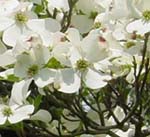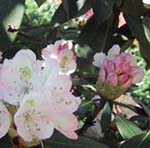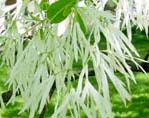 Albemarle County contains a great diversity of plants with prominent spring flowers. Besides the well-known and widespread Dogwood (Cornus florida) and Redbud (Cercis canadensis), local hardwood forests are studded with Spicebush (Lindera benzoin), Black Haw (Viburnum prunifolium), Maple-leaved Viburnum (Viburnum acerifolium), Serviceberry (Amelanchier sp.) and Arrowwood (Viburnum dentatum).
Albemarle County contains a great diversity of plants with prominent spring flowers. Besides the well-known and widespread Dogwood (Cornus florida) and Redbud (Cercis canadensis), local hardwood forests are studded with Spicebush (Lindera benzoin), Black Haw (Viburnum prunifolium), Maple-leaved Viburnum (Viburnum acerifolium), Serviceberry (Amelanchier sp.) and Arrowwood (Viburnum dentatum).
The delicate and airy yellow flowers of Spicebush might be considered the harbinger of spring. Though Red and Silver Maple precede Spicebush, they sometimes bloom so early that winter closes back in around them. By the time Spicebush blooms, spring is truly imminent. Its flowers fade just in time to avoid clashing with the pastel pinks and whites of Redbud and Dogwood that provide the principal drama of a central Piedmont spring.
 Many other species provide accents of color, as the woods gradually darken through the course of the season. Deciduous azaleas (Rhododendron sp.) are somewhat uncommon and often require a more subtle appreciation than their hybridized relatives in the nursery trade. However, evergreen rhododendrons (Rhododendron maximum and R. catawbiense) that are native to higher elevations put on a spectacular display of large flower clusters late in the season.
Many other species provide accents of color, as the woods gradually darken through the course of the season. Deciduous azaleas (Rhododendron sp.) are somewhat uncommon and often require a more subtle appreciation than their hybridized relatives in the nursery trade. However, evergreen rhododendrons (Rhododendron maximum and R. catawbiense) that are native to higher elevations put on a spectacular display of large flower clusters late in the season.
Native roses (Rosa virginiana, R. carolina and R. palustris) typically grow in openings and cleared areas while magnolia species (Magnolia virginiana and M. tripetala) and certain kinds of small dogwood occupy lowlands. The many members of the cherry family (Prunus sp.) also provide reliable displays (typically of white flowers) that can be followed by colorful, edible fruit. For this reason, they are found in the Fruit and Nut Room, as well.
 Some of the species in this area exhibit exceptional fragrance to complement their showy flowers, including Cherokee Plum (Prunus angustifolia), Sweet Shrub (Calycanthus floridus), Fringe Tree (Chionanthus virginicus) and magnolias.
Some of the species in this area exhibit exceptional fragrance to complement their showy flowers, including Cherokee Plum (Prunus angustifolia), Sweet Shrub (Calycanthus floridus), Fringe Tree (Chionanthus virginicus) and magnolias.
Most species of spring-blooming small tree and shrub grow in the shady under story, but some are adapted to full sun, as well. This room is divided into two parts: one open to full sun, the other set in the shade of Tulip Poplar, Ash and Honey Locust trees.
